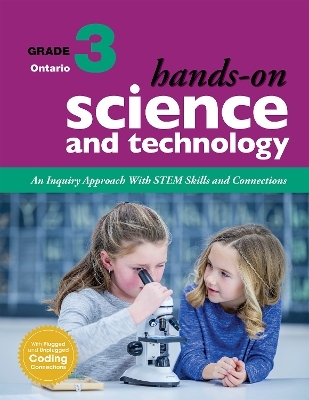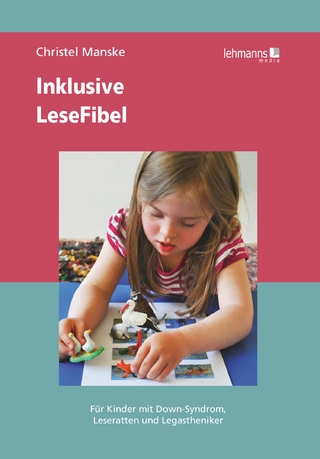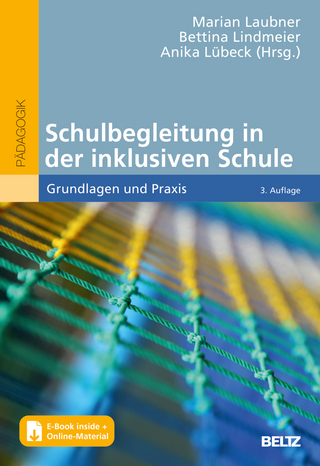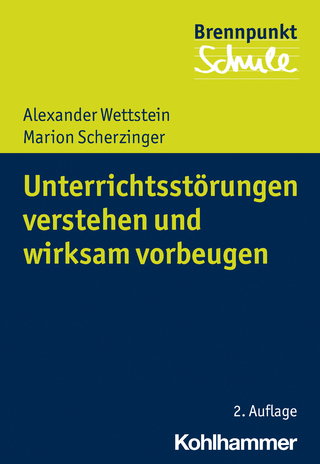
Hands-On Science and Technology for Ontario, Grade 3
Portage & Main Press (Verlag)
978-1-77492-068-8 (ISBN)
- Titel nicht im Sortiment
- Artikel merken
Hands-On Science and Technology for Ontario, Grade 3 is an easy-to-use resource for teaching the five strands of the Ontario science and technology (2022) curriculum:
STEM Skills and Connections
Life Systems: Growth and Changes in Plants
Matter and Energy: Forces and Motion
Structures and Mechanisms: Strong and Stable Structures
Earth and Space Systems: Soils in the Environment
Hands-On Science and Technology for Ontario, Grade 3 encourages students’ natural curiosity about science and the world around them as they participate in hands-on activities and explore their environment. Using the inquiry approach, this comprehensive resource
fosters students’ understanding of STEM (science, technology, engineering, and mathematics) skills
makes coding and emerging technologies approachable for both teachers and students
emphasizes personalized learning using a four-part instructional process: activate, action, consolidate and debrief, enhance
relates science and technology to sustainability and our changing world, including society, the economy, and the environment
focuses on practical applications of the engineering design process as students work on solutions to real-life problems
builds understanding of Indigenous knowledge and perspectives specific to Ontario
explores contributions to science and technology by people with diverse lived experiences
Using proven Hands-On features, this book provides resources for both teachers and students including background information on the science topics; complete, easy-to-follow lesson plans; materials lists; and digital image banks and reproducibles (find download instructions in the Appendix of the book).
Innovative elements developed specifically for the Ontario curriculum include the following:
plugged and unplugged coding activities in nearly every lesson
land-based learning activities
opportunities for students to use the scientific research process, scientific experimentation process, and engineering design process
a fully developed assessment plan to guide assessment for, as, and of learning
ideas and prompts for STEM Makerspace project
Jennifer E. Lawson, PhD, is the creator of the Hands-On books published by Portage & Main Press. As senior writer and editor for the series, she has contributed to more than 50 publications for teachers and students. Jennifer provides professional development workshops for educators locally, nationally, and virtually, and is a Workplace Wellness Advisor. Her most recent book is a collective effort called Teacher, Take Care: A Guide to Well-Being and Workplace Wellness for Educators. She is also one of the founders of Mission to Mexico, an organization that supports schools in some of the most impoverished communities in Puerto Vallarta. Throughout her extensive career in education, Jennifer has worked as a classroom teacher, resource and special education teacher, consultant, principal, university instructor, and school trustee. She lives with her family in Winnipeg, Manitoba. For over 20 years, Kellie Ierullo (she, her, hers) has been an educator with the Toronto District School Board including as a classroom teacher, special education teacher, and now as a teacher-librarian, technology chair and science/STEM lead educator. Kellie is passionate about helping teachers engage students through meaningful coding and STEM activities and encouraging students to move beyond navigating technology to creating it for themselves. Kellie lives in Woodbridge, Ontario with her family. Jennifer H. Manitowabi (she/her/hers) is an Ojibway educator and PhD student at Lakehead University. Throughout her career in education in both Canada and the US, she has worked as a bus driver, classroom teacher, principal, and education director. Jennifer encourages all teachers to incorporate Indigenous worldviews into their lessons and find opportunities to build relationships with the First Nations of Turtle Island. Jennifer is a member of Lac Seul First Nation, where she currently resides, and can often be found creating artwork that celebrates her culture.
Introduction to Hands-On Science and Technology for Ontario, Grade 3 1
Introduction to Hands-On Science and Technology 2
Program Introduction 2
The Inquiry Approach to Science and Technology 2
21st Century Teaching and Learning 3
The Goals of the Science and Technology Program 3
Hands-On Science and Technology Strands and Expectations 4
Hands-On Science and Technology Fundamental Concepts and Big Ideas 4
Hands-On Science and Technology Program Principles 5
Infusing Indigenous Perspectives 5
Cultural Connections 7
Land-Based Learning 7
Technology 7
Sustainability 7
Program Implementation 8
Program Resources 8
Classroom Environment 11
Planning Units—Timelines 12
Classroom Management 12
Classroom Safety 12
Scientific Inquiry Skills: Guidelines for Teachers 12
Observing 12
Questioning 13
Exploring 13
Classifying 13
Measuring 14
Communicating, Analyzing, and Interpreting 14
Predicting 15
Inferring 15
Inquiry Through Investigating and Experimenting 16
Inquiry Through Research 16
Online Considerations 17
Addressing Students’ Early Literacy Needs 17
Technological Problem Solving 17
Makerspace 18
The Hands-On Science and Technology Assessment Plan 20
Assessment for Learning 21
Assessment as Learning 21
Assessment of Learning 22
Performance Assessment 23
Portfolios 23
Evidence of Student Achievement Levels for Evaluation 24
Important Note to Teachers 24
References 25
Assessment Reproducibles 26
Achievement Chart for Science & Technology 41
Unit 1: Growth and Changes in Plants 43
Introduction 44
Unit Overview 48
Curriculum Correlation 49
Resources for Students 51
Websites 53
1 What Do We Know About Plants and Their Needs? 56
2 What Are the Parts of a Plant? 61
3 What Are Some Special Features of Plants? 65
4 How Do Plants Adapt in Order to Survive? 73
5 What Is the Life Cycle of a Plant? 78
6 What Parts of Plants Do We Eat? 84
7 What Are the Different Ways in Which Plants Are Grown for Food? 89
8 How Can We Investigate the Needs of Plants? 94
9 How Can We Design a Terrarium to Sustain Living Things? 100
10 In What Other Ways Are Plants Important to Humans? 105
11 How Can Dye Be Made From Plants? 109
12 How Do Plants and Animals Depend on Each Other? 114
13 How Do Plants Help Reduce Erosion? 118
14 How Can We Protect Plants? 122
15 Inquiry Project: What More Can I Learn About Plant Products? 126
Unit 2: Strong and Stable Structures 129
Introduction 130
Unit Overview 133
Curriculum Correlation 134
Resources for Students 135
Websites and Online Videos 136
1 What Is a Structure? 138
2 Where Are Structures Found? 143
3 Which Materials Are Stronger Than Others? 147
4 What Are Joints? 154
5 How Can We Build Structures to Be Stronger and More Stable? 160
6 How Can We Build a Frame That Is Strong and Stable? 165
7 What Structures Has Nature Engineered? 170
8 How Are Structures Around the World Similar and Different? 176
9 What Are Some Careers in Design and Building? 181
10 What Other Structures Can We Build? 185
11 Inquiry Project: What More Can I Learn About Important Buildings and Structures? 192
Unit 3: Forces Causing Movement 195
Introduction 196
Unit Overview 199
Curriculum Correlation 200
Resources for Students 201
Websites and Online Videos 203
1 What Is a Force? 206
2 How Is a Force a Push or a Pull? 210
3 What Is Friction? 214
4 Which Objects Do Magnets Attract? 217
5 How Is a Magnet Made? 222
6 How Can a Magnetic Force Be Altered? 226
7 How Is Earth Like a Giant Magnet? 232
8 What Are Helpful Uses and Harmful Effects of Magnets? 237
9 What Is Static Electricity, and How Is It Created? 240
10 How Does Humidity Affect Static Electricity? 244
11 How Can the Force of Static Electricity Be Demonstrated Safely? 248
12 How Does an Electroscope Work? 252
13 What Effect Does Gravity Have on Different Objects? 255
14 What Are Some Forces of Nature? 262
15 How Are Forces Used to Move Toys? 266
16 How Can Safety Devices Be Used to Reduce the Effects of Forces? 270
17 Inquiry Project: How Can I Design a Toy or Game That Uses Forces? 273
Unit 4: Soils in the Environment 277
Introduction 278
Unit Overview 281
Curriculum Correlation 282
Resources for Students 283
Websites and Online Videos 285
1 What Do We Know About Soil? 287
2 What Are the Different Types of Soil? 291
3 How Can Soil Components Be Separated? 297
4 How Much Water Can Different Soil Types Absorb? 301
5 How Do Different Soils Affect the Growth of Plants? 306
6 What Lives in Soil? 312
7 How Does Rainfall Affect Soil? 316
8 How Can Organic Materials Be Recycled? 320
9 How Do Humans Use Earth Materials? 325
10 Inquiry Project: What More Can We Learn About Products Made From Earth Materials? 328
References 333
Appendix: Image Banks 335
About the Contributors 353
| Erscheint lt. Verlag | 27.11.2024 |
|---|---|
| Co-Autor | Kellie Ierullo, Jennifer Manitowabi |
| Zusatzinfo | Illustrations, unspecified |
| Sprache | englisch |
| Maße | 215 x 279 mm |
| Themenwelt | Schulbuch / Wörterbuch ► Unterrichtsvorbereitung |
| Naturwissenschaften | |
| Sozialwissenschaften ► Pädagogik ► Schulpädagogik / Grundschule | |
| ISBN-10 | 1-77492-068-9 / 1774920689 |
| ISBN-13 | 978-1-77492-068-8 / 9781774920688 |
| Zustand | Neuware |
| Haben Sie eine Frage zum Produkt? |
aus dem Bereich


